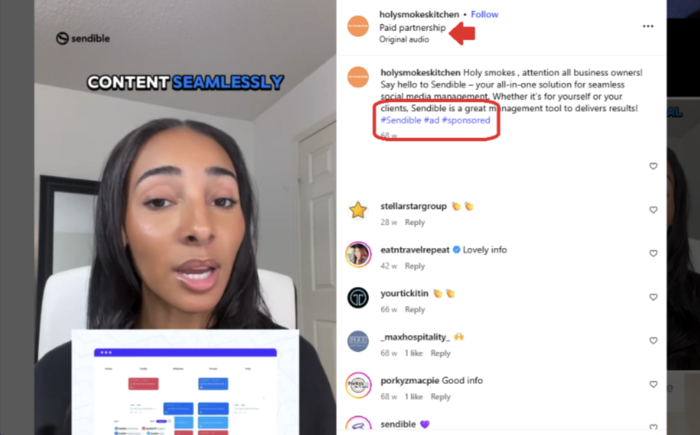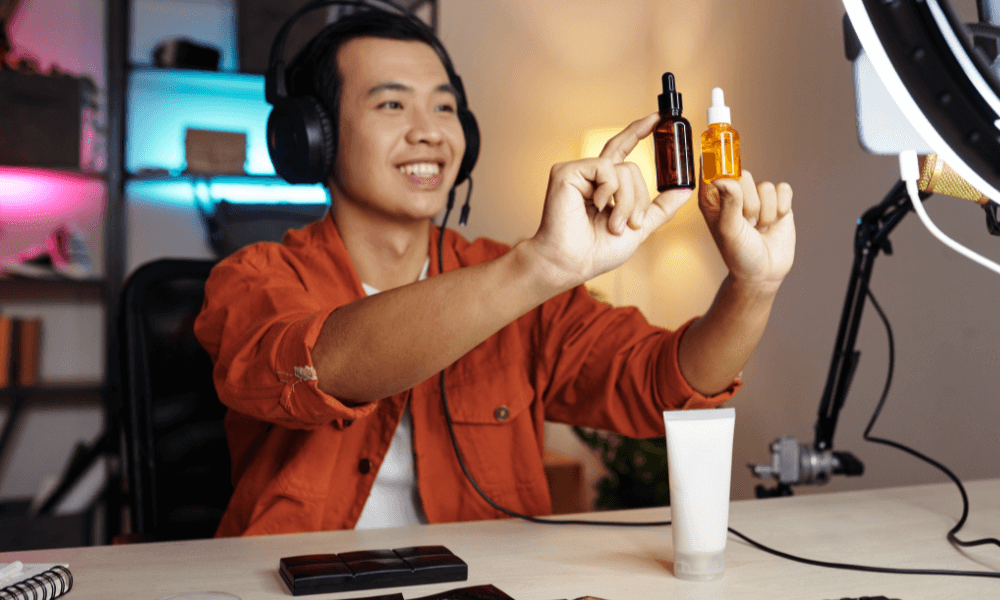Sendible insights Brand Ambassadors: Turning Local Voices Into a Scalable Social Strategy
You can’t be everywhere at once. But your brand can.
That’s the promise of a brand ambassador program: turning local team members, superfans, and community voices into a network of trusted storytellers. The challenge is keeping all content on-brand without turning every post into a copy-and-paste job.
So, how do you build something that works across 5, 50, or 500 locations? It starts with the right people, tools, and a clear plan for what great looks like. Whether you're launching from scratch or levelling up an existing program, we’ll walk you through the structure, content ideas, and systems that make it scalable.
And yes, Sendible fits right in. From content approvals to shared asset libraries, we'll show you how to keep everything connected without micromanaging every post.
Table of Contents
- What is a brand ambassador?
- Brand Advocate vs Brand Ambassador vs Influencer
- Why brand ambassadors are perfect for multi-location businesses
- Where to find the right brand ambassadors
- How to create a brand ambassador program
- Social media campaign for brand ambassadors
- Brand ambassador program examples by industry
- Tips for maintaining alignment across locations
- How can Sendible help with brand ambassadors?
What is a brand ambassador?
A brand ambassador is someone who represents your business in a long-term, intentional way. Unlike “brand evangelists” or happy customers who promote you on their own, ambassadors are usually part of a formal setup.
They’re often paid or rewarded with perks like free products, exclusive access, or commission, and play a clear role in your marketing efforts.
You’ve seen brand ambassadors at every level, from global icons like Tiger Woods with Nike, who helped redefine the brand’s image in golf, to local fitness instructors promoting their favourite smoothie shop on Instagram.
The structure is the same: an intentional, long-term partnership that builds trust, awareness, and community, just at different scales.
What makes ambassadors so effective is their ability to put a face to your brand, especially across different regions. They help shift your messaging from corporate to personal, sharing real stories, connecting with local audiences, and showing what your business looks like in action.
The key difference between a brand ambassador and a casual advocate is the intention of the relationship. Ambassadors are aligned with your goals and your voice. They’re not tagging you for fun. They’re part of your strategy, helping you build relationships, drive awareness, and grow trust in a way that feels organic.
Brand Advocate vs Brand Ambassador vs Influencer
|
Type |
Compensation |
Brand Relationship |
Ideal for |
|
Brand Advocate |
None (organic) |
Unofficial |
Loyal customers, superfans |
|
Brand Ambassador |
Paid or incentivised |
Formal |
Structured campaigns, brand messaging |
|
Influencer |
Paid (e.g. per post) |
Transactional |
High-reach, one-off or short-term promotions |
Why brand ambassadors are perfect for multi-location businesses
For multi-location brands, scaling trust across regions is a constant challenge. Brand ambassadors offer a structured, cost-effective way to build local visibility without reinventing your strategy at every branch.
Here’s why they work so well:
- They represent your brand locally and consistently: Brand ambassadors become recognisable faces in their communities, whether they’re employees, customers, or creators.
- They tell location-specific stories while staying on-brand: Ambassadors highlight what’s unique about each location (local events, team moments, community highlights) while still operating within a central content strategy.
Lululemon’s ambassador program started with local, community-focused voices who embodied the brand’s values in their own regions.
- They build trust in regional communities: Traditional influencer campaigns are often one-and-done, transactional, and expensive. In contrast, ambassadors are typically paid or incentivised over time, giving you a reliable stream of authentic content from people who understand your business.
- They drive engagement, brand recall, and foot traffic: Social posts from local ambassadors often get higher engagement than brand accounts alone. That visibility turns into clicks, calls, and visits.
When Zendaya was named a Louis Vuitton ambassador, 97% of campaign revenue came from the social buzz — before she even posted.
For brands managing tens, hundreds, or thousands of locations, ambassadors offer a rare mix of scalability and authenticity. They localise your message at scale.
Where to find the right brand ambassadors
The strongest ambassadors aren’t always high-profile influencers or big-name creators. More often, they’re people who already have a natural connection to your business.
Finding them starts with knowing where to look and what signals to pay attention to.
- Employee brand ambassador: Staff with personality, camera confidence, and a public-facing role are ideal. Think baristas with a local following, stylists who post their work, or gym instructors already active on TikTok.
@onepeloton @Logan Aldridge breaking down how to do a barbell clean & jerk (a lifting exercise similar to clean and press) 💯 Save for your next gym session #barbellcleanandpress #barbellcleantutorial
♬ original sound - Peloton
These employees bring everyday access and authentic content, and they already speak in your brand’s voice, just more naturally. Giving them the framework to post with intention can turn daily interactions into scalable brand storytelling.
- Loyal customers: Frequent customers who tag your locations, share experiences, or comment consistently are already doing the work of advocacy.
Formalising that relationship with perks or exclusive access turns casual content into brand-aligned promotion. These individuals can help build credibility in peer networks where traditional marketing doesn’t land.
- Franchisees and local owners: Beyond their operational role, franchisees are often seen as trusted figures in their local area. When they share business milestones, events, or staff stories, the content carries authority and relevance.
With support from your business’s headquarters, they can act as community-facing ambassadors without going off-brand.
- Micro-influencers in niche or local markets: These creators might only reach a few thousand people, but if those followers are local and engaged, the impact can be far more targeted than a larger, less relevant account.
Look for creators whose style fits your tone and who already post content within your industry.
- Community figures and student reps: Coaches, university ambassadors, and organisers of local events. These people have presence, trust, and often untapped reach. They’re especially valuable when launching new locations or promoting region-specific campaigns.
To identify potential, tap into tools like Instagram search, local hashtags, social media analytics features, and feedback from store managers who know who’s already active and influential on the ground.

Influencer Marketing: What It Is, How It Works, and Why It’s So Powerful
How to create a brand ambassador program
To make a brand ambassador programme work at scale, you need more than a good idea. You must have a structure that relates to your goals, incentives, execution, and oversight.
Here’s how to design a programme that works across locations without losing control of your message.
- Define your goals: Start by aligning your ambassador efforts with real business outcomes, for example:
- Generate 30 pieces of tagged user content for a seasonal campaign.
- Increase in-store event attendance in underperforming regions by 20%.
- Drive 100 redemptions of a location-specific offer over four weeks.
- Choose incentives: Make the reward fit the goal. Some locations may need monetary incentives, and others thrive on exclusivity. Common incentives include:
- A monthly fixed payment for agreed deliverables.
- Commission on referred bookings or redemptions.
- Access to new product drops before public release.
- Payments per post.
- Provide clear expectations: Set consistent guidelines across all regions, with room for local tweaks. For example:
- Post twice monthly on Instagram and TikTok, tagging local pages
- Use the branded hashtag and location-specific tag (e.g. #BrewHausGlasgow).
- Represent the brand voice (helpful, down-to-earth, or formal).
- Always disclose paid partnerships clearly.

-
- Centralise ambassador content via platforms like Sendible: Social media management platforms let you manage ambassadors across different locations with tools that help you execute clean, scalable campaigns.
- Multi-location dashboard and role-based access: Connect all location accounts in one visual dashboard. Set customised user permissions (e.g., HQ planners vs regional managers) so everyone sees only what matters.
- Structured post approvals and task assignments: Draft posts can be submitted for review with comments, notifications, and approval flows. This ensures local content remains on-brand before it goes live.
- Content library with templating and bulk tagging: Save approved assets, like videos, images, and captions, as reusable templates. Use custom tags (e.g., #SpringLaunchManchester) to make location tweaking easy.
- Schedule localisation at scale: Bulk-import content for dozens of locations, tailor copy or images where needed, and schedule across region-specific posting windows, all from a single dashboard.
- Advanced analytics per region: Track likes, reach, and engagement metrics by location. Automated reporting makes it easy to highlight successful ambassadors or campaigns.
- Centralise ambassador content via platforms like Sendible: Social media management platforms let you manage ambassadors across different locations with tools that help you execute clean, scalable campaigns.
By consolidating these features, Sendible helps brands maintain a consistent voice across regions without stifling local creativity or visibility.
Social media campaign ideas for brand ambassadors

4 Types of Influencers and Differences: Nano, Micro, Macro, Celebrity
Once your ambassador programme is in motion, the next step is creating campaigns that spark engagement in local markets while maintaining brand consistency.
The ideas below are personal, repeatable, and designed to align with your voice, visuals, and messaging, no matter the region.
- “Day in the Life” Stories: Showcase frontline staff or local owners walking through a typical day, from opening duties to customer moments. These bring personality to your brand and make behind-the-scenes content feel authentic.
- Reel Takeovers: Let ambassadors create short-form content around new product launches or in-store events. With the right guardrails, Instagram takeovers can drive real-time engagement without losing control of the brand narrative.
- Community Spotlights: Ask ambassadors to create content around what makes their location stand out. This could be a behind-the-scenes look at how their store serves a specific neighbourhood need, a feature on a local charity partner, or a shoutout to a nearby small business they collaborate with.
- Testimonial Content: Use video clips or carousels where ambassadors explain why they love working with or supporting your brand. Keep the tone real, not scripted.
These formats can be created in batches, scheduled ahead, and tracked through a tool like Sendible to spot what’s working in each region.
Brand ambassador program examples by industry
Brand ambassadors work best when their content feels grounded in the everyday experience of each location, without losing sight of the bigger brand story.
Social media brand ambassador programmes look different in every industry, but the goal is the same: turn local personalities into trusted faces for your business.
Here’s what that looks like in practice.
- Real estate: Local agents use LinkedIn and Instagram to share success stories, client wins, and market insights, positioning themselves as trusted community experts while amplifying the brand’s reach.
- Dental clinics: Hygienists and assistants film short clips showing what a first visit looks like, explain common treatments, or share oral health tips. These human touches help reduce patient anxiety and build trust before someone even walks through the door.
- Franchise coffee chains: Baristas post quick Reels promoting daily specials, sustainability initiatives (like reusable cup schemes), or staff favourites. It keeps content fresh, relatable, and location-specific.
- Gyms and fitness centres: Trainers act as ambassadors by sharing their workouts, spotlighting client progress, or showing tips for using new equipment. This builds credibility and drives local sign-ups.
- Restaurants: Waitstaff or chefs highlight seasonal dishes, behind-the-scenes prep, or short customer interviews. It gives personality to the brand and encourages locals to visit “their” branch.
The format might shift by industry, but the approach stays focused. Highlight local voices, keep the message consistent, and let ambassadors lead with authenticity.
Tips for maintaining brand alignment across locations
It’s one thing to activate ambassadors, but it’s another to keep everyone in sync. When your brand is being represented in different cities, by different people, across different channels, consistency doesn’t happen by accident.
Here’s how to keep things cohesive without turning every post into a carbon copy:
- Build a central brand hub: Make it easy for ambassadors to access approved logos, templates, and messaging. A shared folder or asset library keeps branding tight without slowing anyone down.
- Set creative boundaries, not rules: Local content performs best when it feels real. Give ambassadors a framework, like key hashtags, tone of voice, and disclosure requirements, but leave room for their voice.
- Use tools that support multi-location workflows: Platforms like Sendible let you build approval flows, monitor location-based accounts, and spot off-brand content before it goes live.
- Plan content and training quarterly: A 90-day rhythm helps regional teams align around campaigns and refresh their skills. It also gives you a chance to update assets and keep messaging sharp.
Clear systems and shared assets give every ambassador the confidence to create content that fits their audience while still supporting your brand’s strategy.
How can Sendible help with brand ambassadors?
A successful brand ambassador program needs the right systems behind it, especially when you’re managing multiple locations.
With Sendible, you can distribute pre-approved visuals and messaging, manage approvals with built-in workflows, customise posts with Custom Tags, and track what’s performing across different regions. It keeps your content consistent, scalable, and easy to manage, no matter how many voices are telling your brand story.
Try Sendible free for 14 days and manage every part of your ambassador program, from scheduling and approvals to local content tracking, with less guesswork and more control.
Freya Laskowski
Freya is an SEO consultant that helps brands scale their organic traffic with content creation and distribution. She is a quoted contributor in several online publications, including Business Insider, Fox Business, Yahoo Finance, and the Huffington Post. She also owns CollectingCents- a personal finance blog that she grew from the ground up.
You can reach out to her at freya@collectingcents.com
Text copied!


